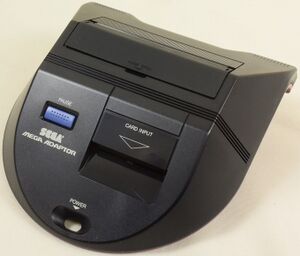Power Base Converter
From Sega Retro
One of the key design features of the console is its compatibility with its immediate predecessor, the Master System. The 16-bit design is based upon the 8-bit design, albeit enhanced and extended in many areas. As the cartridge slot is of a completely different shape, Sega released the Power Base Converter, a separate device that sat between a Master System cartridge and the new shape of cartridge slot. Due to the high level of backwards compatibility, the Power Base Converter does not contain any Master System components - it is essentially a method of fitting a square peg into a round hole. The converter contained 2 slots. The top slot was for cartridge based games. The front slot was for card based games. The Power Base Converter would be fully compatible with the Genesis 2, were it not for the different shape of the Genesis 2's casing. One can remove or modify the PBC casing, allowing it to work on a Genesis 2.
In order to achieve backwards compatibility, the original Master System central processor and sound chip (the Z80 and SN76489) are included in the Mega Drive/Genesis and the new Video Display Processor is capable of the Master System VDP's mode 4 (though it cannot run in modes 0, 1, 2, or 3). Once an 8-bit game is inserted, the system's bus controller chip (later integrated with the I/O chip into a single multi-purpose ASIC) will put the Z80 in control leaving the 68000 idle.
Both 2-button Master System pads and standard Genesis pads can be used to play SMS games. Due to slight differences in how the Genesis pads operate, some Master System games may inadvertently cause the wrong set of inputs to be selected in a 3/6-button pad and prevent input from working properly. In this case a Master System controller must be used. Like the Master System, the PAUSE button is not part of the gamepad connector and instead is implemented as a pushbutton switch on the Power Base Converter or similar devices.
In Japan, the device was known as the Mega Adaptor and the PAL variant was called the Master System Converter. In order to make it compatible with the new Mega Drive II, a second PAL converter, the Master System Converter II, was also released.
